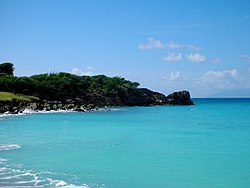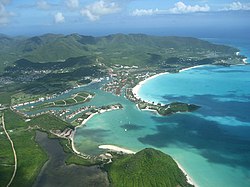Antigua
Antigua (IPA: /ænˈtiːgə//an-tee-gah) is an island in the West Indies, Leeward Islands in the Caribbean region, the main island of the country of Antigua and Barbuda. It is also known as Wadadli, which means approximately "our own". The island's circumference is about 87 kilometres (54 miles) and its area is 281 km² (108 square miles). About 69,000 people lived there as of July 2006.[1] It is the largest of the Leeward Islands, and has a busy economy based on tourism, internet gambling, and education, including two medical schools.
Indigenous peoples like the Ciboney, Taíno, and Kalinago had lived on and around the island for a long time. But in 1493, Christopher Columbus became the first European to visit, and he renamed it Antigua after Mary, the mother of Jesus. The British came in 1632 and colonized the island. They brought slaves to the island from Africa who were forced to grow sugar cane. The slaves were legally freed in 1834.[2]
The island stopped being a part of Britain in 1981. It is now a country with Barbuda.[2]
Antigua Media
Aerial view of Jolly Harbour on the western coast of Antigua
References
- ↑ "Nation by Nation population estimate". Archived from the original on 2008-06-29. Retrieved 2007-12-05.
- ↑ 2.0 2.1 "A Plan of the Estate Called Jonas's Situated in the Division of North Sound in the Island of Antigua, the Property of Peter Langford Brooke, Esquire". World Digital Library. Retrieved 19 April 2013.








